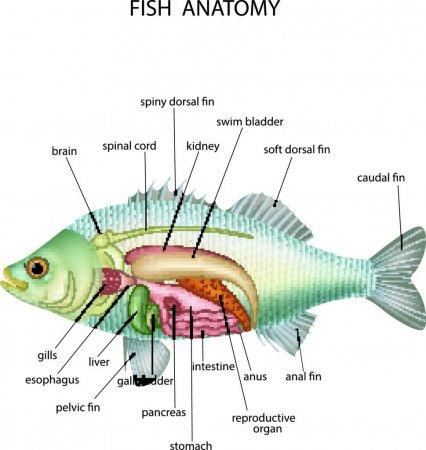
Describe the process of respiration in fish.
Answer
495k+ views
Hint: Respiration in aquatic animals is different from terrestrial animals because of the low amount of oxygen present in water.
Complete answer:
Fishes are living in water and possess gills at either side of their head that are made up of feathery structures known as gill filaments. The gills of vertebrates typically grow in the walls of the pharynx, with a series of gill slits opening to the exterior. Fish consume oxygen-rich water through their mouths and pump it through their gills. As water passes from the gill filaments, blood inside the capillary network extracts the dissolved oxygen. The circulatory system then transports the oxygen to all body tissues and finally to the cells while picking up carbon dioxide which is removed from the body through the gills.
Functions of gills:
- Fish gills are organs that allow fish to breathe underwater by exchanging the oxygen and carbon dioxide using gills.
- As water contains a very low amount of dissolved oxygen, fish exchange gases by pulling oxygen-rich water through their mouths and forcing it over their gills.
- These gills are connected with blood vessels for the easy exchange of gases.
- Gills help the vertebrates to increase their surface area for oxygen exchange.
- Gills transfer the ions and water, as well as the exchange of oxygen, carbon dioxide, acids, and ammonia.

Figure: Internal structure of a fish
Note: Most fish are ectothermic or cold-blooded allowing their body temperatures to differ as ambient temperatures change however, some of the large fishes like white shark and tuna can hold a higher core temperature.
Complete answer:
Fishes are living in water and possess gills at either side of their head that are made up of feathery structures known as gill filaments. The gills of vertebrates typically grow in the walls of the pharynx, with a series of gill slits opening to the exterior. Fish consume oxygen-rich water through their mouths and pump it through their gills. As water passes from the gill filaments, blood inside the capillary network extracts the dissolved oxygen. The circulatory system then transports the oxygen to all body tissues and finally to the cells while picking up carbon dioxide which is removed from the body through the gills.
Functions of gills:
- Fish gills are organs that allow fish to breathe underwater by exchanging the oxygen and carbon dioxide using gills.
- As water contains a very low amount of dissolved oxygen, fish exchange gases by pulling oxygen-rich water through their mouths and forcing it over their gills.
- These gills are connected with blood vessels for the easy exchange of gases.
- Gills help the vertebrates to increase their surface area for oxygen exchange.
- Gills transfer the ions and water, as well as the exchange of oxygen, carbon dioxide, acids, and ammonia.

Figure: Internal structure of a fish
Note: Most fish are ectothermic or cold-blooded allowing their body temperatures to differ as ambient temperatures change however, some of the large fishes like white shark and tuna can hold a higher core temperature.
Recently Updated Pages
Questions & Answers - Ask your doubts

Master Class 11 Accountancy: Engaging Questions & Answers for Success

Master Class 11 Science: Engaging Questions & Answers for Success

Full Form of IASDMIPSIFSIRSPOLICE class 7 social science CBSE

In case of conflict between fundamental rights of citizens class 7 social science CBSE

Can anyone list 10 advantages and disadvantages of friction

Trending doubts
10 examples of friction in our daily life

The correct order of melting point of 14th group elements class 11 chemistry CBSE

Difference Between Prokaryotic Cells and Eukaryotic Cells

One Metric ton is equal to kg A 10000 B 1000 C 100 class 11 physics CBSE

What is the specific heat capacity of ice water and class 11 physics CBSE

State and prove Bernoullis theorem class 11 physics CBSE




